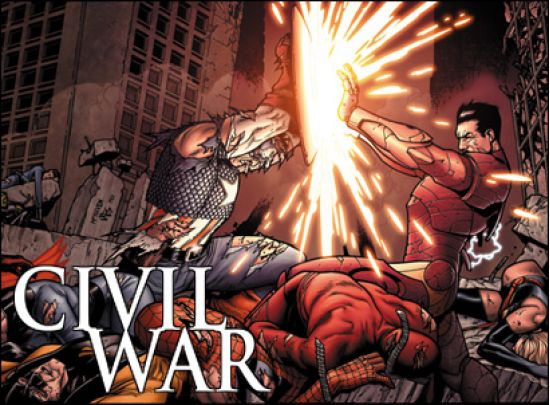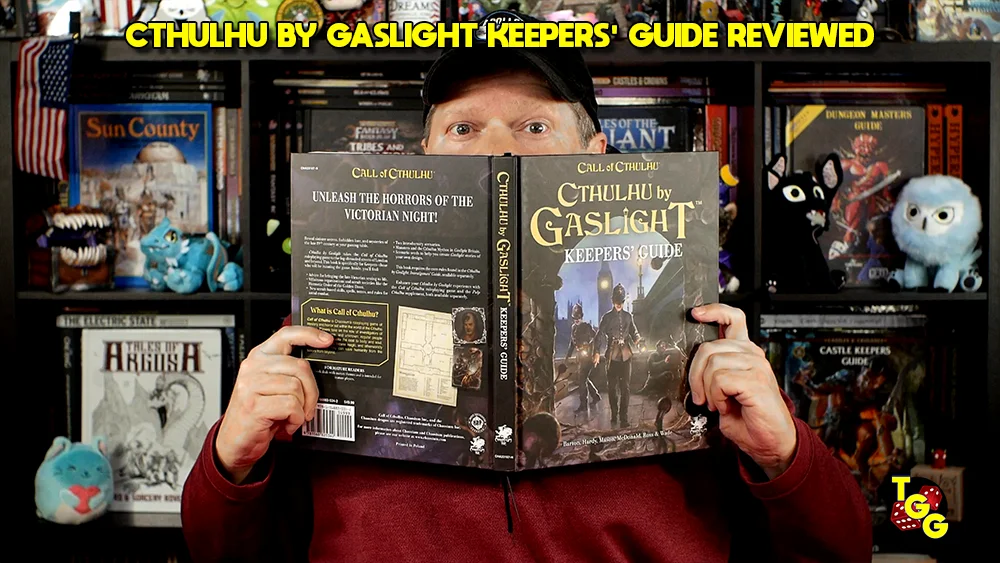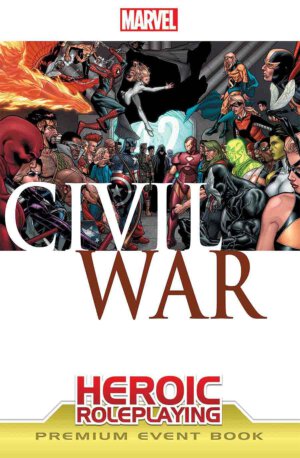
Publisher: Margaret Weis Productions
Authors: Cam Banks, Dave Chalker, Robert Donoghue, Matt Forbeck, John Harper, Will Hindmarch, Jeremy Keller, Philippe-Antoine Ménard, Jack Norris, Jesse Scoble, and Aaron Sullivan
Year: 2012
Players: 2 or more
Ages: 12+
Category: Superhero RPG campaign
Pages: 224 for the Premium Edition and 160 for the Essentials Edition
Retail Price: Premium $39.99 hardcover, $23.99 PDF and Essentials $29.99 hardcover, $17.99 PDF
Back in April I handled the review duties for Marvel Heroic Roleplaying, the Marvel Comics roleplaying game which had just arrived from Margaret Weis Productions. I have to say I thought it was a good base system, although not perfect – what game is? – and was looking forward to the promised Event books which were coming down the pike. These Events were to be milestones in the Marvel universe that you’d be able to role play with your friends and I was particularly intrigued to see Civil War was to be the initial release. Interestingly enough, the event was what brought my brother back into comic collecting after about twenty years away from the hobby.
Before I begin it’s important to note there are two options as far as picking up the supplement. The first is just the supplement itself, going by the name of the Essential edition, which clocks in at 160 pages which include the campaign and additional hero files, which retails for $29.99. The second is called the Civil War Premium Edition and that includes the base rules (or Operations Manual) along with all the stuff in Essentials for a $39.99 price tag with 224 pages; that saves ten bucks on separate purchases of Civil War and the MHR rules. There are also plans to release smaller mini-supplements for the larger Event books, more narrowly focused on specific teams or story threads within the individual Events. For Civil War, three are planned, each roughly one month after the other: Civil War 50 State Initiative, Civil War X-Men, and Civil War Young Avengers and Runaways. These will clock in at $19.99 and are entirely optional. I have to admit though if all three are bought and combined with the main Civil War book we’re talking a pretty ambitious campaign project. Now Civil War is out and it’s time to see just how this Marvel milestone is presented.

Some readers may be wondering what is Civil War? Civil War follows the implementation and consequences of the Superhuman Registration Act, a legislative bill which required the mandatory registration of any person based in the United States with super powers. The act arose due to public pressure for accountability following a series of superhuman-related events causing significant damage and death within the Marvel universe, such as an attack on Manhattan in reprisal for Nick Fury’s “Secret War”, and the Hulk’s rampage in Las Vegas which resulted in the death of 26 people. When the mutant population was drastically reduced in the aftermath of M-Day, itself caused by a mutant, anti-mutant hysteria caused by extremist groups caused a majority of the remaining mutants, known as the 198, to relocate to the Xavier Institute, and raised public support for the proposed act.
Public sentiment toward superheroes plummeted after the New Warriors, a group of young superheroes and the focus of a reality TV show, botched an attempt to apprehend a group of supervillains in a quest for better ratings. In the resulting fight the villain Nitro used his explosive powers to destroy several city blocks, including an elementary school at the epicenter, resulting in the death of over 600 civilians, 60 of whom were children, with just Speedball of the Warriors and Nitro himself surviving. Although many high-profile superheroes assisted in the relief and rescue effort, there were a number of isolated revenge attacks, and support for registration rose.
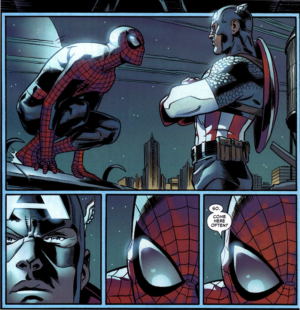
And at that point I will end the the potential for spoilers because many gamers will be happy to know the way the Civil War Event is presented anything is fair game. For an example you don’t have to have Iron Man leading the pro-registration forces nor Captain America championing anti-registration. Hell, you can switch their roles easily enough in fact as there’s enough in the heroes’ backgrounds to warrant a change in attitude. You could even choose to team them up on the same side. The same goes for any of the heroes in the Marvel canon.
The supplement is divided into three Acts. Within these Acts are Scenes and it’s mentioned that Scenes can take as long as an entire play session or be as short as a few minutes or so of gaming. Just as in the comic book world, time is a fluctuating concept and those who are intimately familiar with RPGs won’t have an issue with this. Other folks who are just getting into the hobby, possibly even based on their interest in Marvel comics, may have to take a moment to understand things can jump around pretty regularly as far as how time plays out in game.
Civil War may come across quite a bit differently than many people expected as this is not a rigidly plotted supplement but a collection of adventure threads tied together within each Act. Most of the action takes place within the time frame of the Act – playtime is given for each Act as approximately a month or so for gaming groups who get together regularly – and the Watcher (GM) isn’t saddled with having to include every single scene included. Granted, to get the most bang for your buck you’ll want to tackle as much of the included material as you can but you won’t be tied down by specifically having to game every Scene.
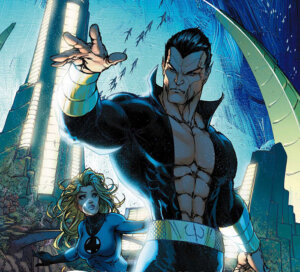
I certainly like Civil War but there are a few problems I have with the release. To start off I’ll the same issue I had with the core rules remains with the supplement; namely the fact character creation is still fnearly nonexistent. I understand the big appeal for many is role playing your favorite Marvel characters but I personally want to channel my inner Stan Lee or Jack Kirby and jump into the Marvel universe with my very own superhero. Sadly enough, the structure for doing just that is weak to say the least. Granted, the rules are there, they just aren’t tight enough to provide for a solid creation set up. Or at least they fall short in my estimation.
Also keep in mind with as much information packed in the Civil War supplement those who aren’t intimately familiar with the event are going to find things a bit confusing. I understand the concept of railroading players is frowned upon, although I’m of the firm belief that tightly plotted adventures are still the most memorable, but the story comes across as a wee bit too open ended. The second Act comes across as a scattershot affair in many areas. If someone never read Civil War (and even those who did may have a hard time remembering all that took place as it was five years ago) they’re going to find large gaps in understanding what exactly is taking place. If not then of the what certainly the how and why of the Scenes a good deal of the time. A great example of this limited information is the catastrophic event which set off much of the action. This tragedy occurs in Stamford, CT but there isn’t a whole lot of solid info provided about it. What happened is touched upon but not in much detail. This approach is used in many of the scenes and, while I can understand the logic behind it as you’re given the opportunity to craft the campaign to your own ends, it would have been much more helpful to understand the hows and whys of what’s taking place as they pertain to the original comics while at the same time giving the GM and players free rein.
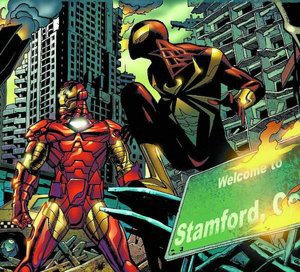
Finally the book includes thirty two data files for heroes and villains and although there’s a bit of overlap between what’s included here and in the core rules there are some differences in the characters themselves and I like the way they’re presented in Civil War as opposed to the core book. I suppose the argument the characters do change from one storyline to another in the comics carries weight here so the overlap isn’t a huge deal. Sure, as a fan of all things Marvel, I’d like to see more heroes and villains added to the mix but you still receive a good overall selection in the sourcebook.
There is a lot to like about Civil War and I’m sure many of the scenes are going to be a blast to play out so I’m not looking to dissuade anyone from picking this up. Honestly, if I had to make a choice as to picking up the corebook or the Premium edition of Civil War (with the core rules included) I’d say my choice would be the latter. I actually like the new product a touch more than I did the rulebook in presentation as far as the rules and hero files. The sourcebook is a serious undertaking by Margaret Weis Productions and with the upcoming three additional supplements for the event – which will run about twenty bucks each – I can easily see a dedicated GM and group of players digging deeply into this event (especially with troupe play) to a good six months or more of adventuring out of Marvel Civil War. Add to this the ability to take the tale off in any number of directions and Civil War is a must have for folks looking to play in the Marvel Universe sandbox.
On a final sidenote… I did mention I followed Civil War as it unfolded in the pages of Marvel Comics and, if you’re curious, I was anti-registration (and Captain America) all the way!
[rwp-review id=”0″]


